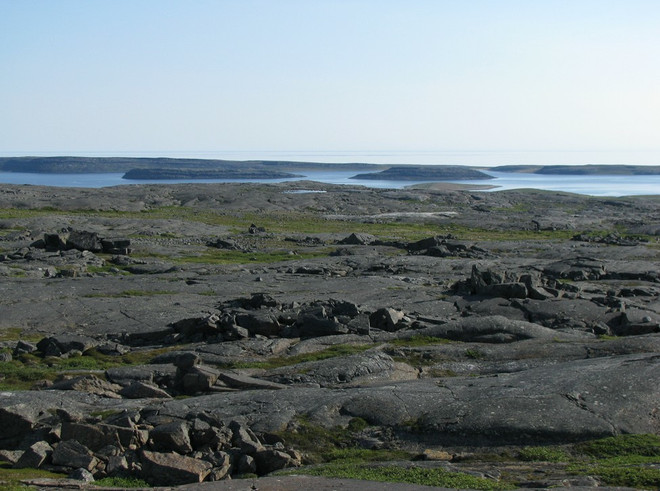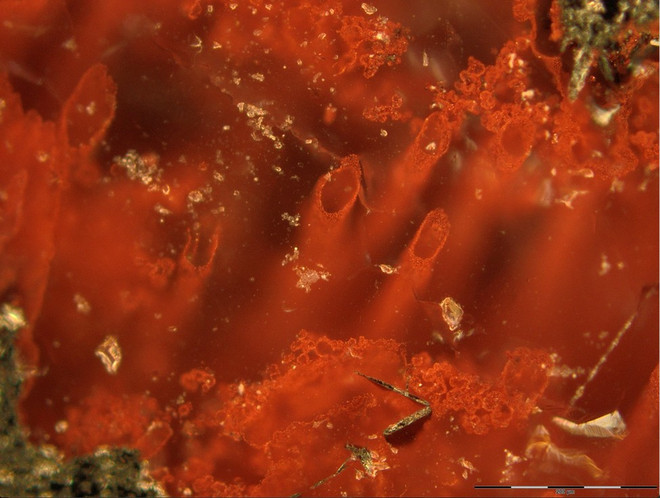Earth's oldest life has just been discovered in Northern Canada
The international team of researchers said these "creatures" are between 3.8 billion and 4.3 billion years old - turning them into the oldest "creatures" ever found on our planet.
About 35km north of Inukjuak - an Inuit village in northern Quebec - about 35km there is an unusually rising rock strip from the ground. This strip of rock is known as Nuvvuagittuq Supracrustal Belt , composed primarily of gray-blue stones, with red veins. If you climb on this rock, and you are not a geologist, then perhaps you will not realize what you are standing on. These rocks are thought to have formed billions of years ago at the bottom of prehistoric oceans , near ancient hydrothermal vents. And they carry on themselves a sign of an incredible ancient life form, capable of rewriting the history of planet Earth!
An international team of researchers says the stone is between 3.8 and 4.3 billion years old - the oldest rock ever found on our planet. But that is not all.Their peculiar structure is a sign of the presence of ancient strains of microorganisms , turning them into the oldest "fossils" ever discovered, and also the oldest life record on the Earth. Land.

Nuvvuagittuq Suprcrustal Belt, behind is a small part of Nastapoka island.
Our planet is only about 4.5 billion years old. At a time when this rock formed, the Earth just cooled down and the new ocean formed only a few hundred million years ago, the atmosphere was very toxic and the state of the planet could hardly allow any form. What life we know today exists. This early period of the Earth - known as the Hadean Eon , fell between 4.5 and 4 billion years ago - so much like hell that it was named after Hades (the God of Hell's Divine Governing God. Greek).
It is one of the reasons why such discoveries are so important: if life can arise on the early Earth, they can also arise on other planets!

Haematite tubes from NSB sediment at hydrothermal vents show the oldest micro-fossils on the planet and are also evidence of life on Earth.
The geochemist Dominic Papineau - from Quebec - made a field trip to the northern area of the province in 2011. To get here, he had to fly 3 continuous flights on the machines. Fly a small propeller, with 3 hours to sail.
Papineau did not expect to find fossils, mainly because the rocks here were severely metamorphosed (meaning they underwent changes under great pressure and heat beneath the Earth's crust - a process that was supposed to destroy any signs of life.)

The bright red refracting layer of the hematite siliceous stone contains microorganisms.A dark green volcanic rock at the top right shows hydrothermal precipitates on the seabed
It is strange to see this bright red metallic battle scattered among the gray-green scenery, Papineau said."A hypothesis about this type of stone is that it has a biological impact in their formation process," said University of London professor (UCL).
Certain types of bacteria that survive today can "harvest" nutrients from iron through a chemical reaction. Papineau wondered if similar organisms existed about 4 billion years ago?
"I was intrigued by the appearance of this stone, so I took them," Papineau said. "But what makes me think there's something important that might be stored inside them when I look for them?" see the pearls of quartz (deposited minerals formed by bacteria) in the field ".
Red iron deposits (hematite - a kind of iron mineral) found in quartz pearls have formed many tubular structures, filaments, beads, and rosettes. Although this suggests that this stone is of biological origin, it is only "capable" . There are many ways to create such structures through abiotic interactions, so Papineau and other scientists will have to study further. An interesting feature of the aforementioned form is that other mineral layers surround them.
"The rosettes we obtained are made of carbonate and apatite and carbon graphite. Carbonate and apatite are what make up bones," he said.

The tiny rosette is made of iron-carbonate with concentric quartz layers and the core of a single quartz crystal with a small amount of red hematite from Nuvvuagittuq Supracrustal Belt.
In other words, these are highly organic materials capable of originating from fossils.
At UCL, Papineau and author author Matthew Dodd used microscopes and spectroscopy to continue studying these types. Finally, they concluded that there is evidence of fossilization of ancient iron oxidizing organisms.
There are only a few places in the world where you can find rocks that are similar in age. One of them is the accretion structures in Greenland. In 2016, scientists announced that they discovered fossils dating to 3.7 billion years there, and at the time of discovery, they were the oldest fossils ever known.
These fossils are formed during the same geological period with the rocks in this article, and are made up of oxygen "breathing" microorganisms. That means not only life at the very early stages of our planet, but they are also quite diverse.
"If there are actually oxygen-producing bacteria, there are also iron oxidizing bacteria near hydrothermal vents, life is quite diverse, because these bacteria are involved (albeit quite far away). ) with today's microorganisms, " Papineau said.

A stacked stone column is made by the Inuit.
Finding two distinct branches of life at the very beginning of planetary history opens the door to search for life on other planets. If two separate species of bacteria can live on Earth so early, they can also be found near hydrothermal vents on ancient Mars seas, or just inside the underground ocean of Europa. ? Scientists have found hematite nodules on Mars, in the form of "blueberries" discovered by adventurer vehicles Opportunity.
Papineau chose Quebec as a target because after learning about the study in Greenland, he knew similar specimens could be found closer to him."This is my home province. This is my country" - he said. By discovering the ancient rocks of this northern region, he and his colleagues rewrote the history of life on Earth.
- Discovering evidence of Earth's oldest life
- The lake nearly 3 billion years can contain alien life
- Discover the oldest animal fossils
- Footprints emigrated to North America from 13,200 years ago
- Discovered the village is longer than the Egyptian pyramid
- The oldest fossil on Earth
- 10 oldest antiquities in the world
- 14 oldest ancient artifacts in the world
- The world's oldest mural in Syria
- Evidence of 4 billion years of life on Earth is discovered
- Video: The oldest life forms on Earth
- 'The oldest person in the world' dies at the age of 123 and the secret of a long life is amazing
 Discovered an ancient centipede fossil 99 million years old
Discovered an ancient centipede fossil 99 million years old Discovered bat-like dinosaurs in China
Discovered bat-like dinosaurs in China Discovered a 200-year-old bronze cannon of the coast
Discovered a 200-year-old bronze cannon of the coast Discover 305 million-year-old spider fossils
Discover 305 million-year-old spider fossils